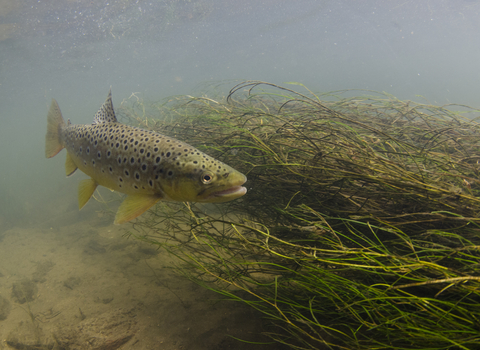
Brown Trout ©Jack Perks
Brown trout
A fierce predator of small fish and flying insects, the brown trout is widespread in our freshwater rivers. It is has a golden body, flanked with pale-ringed, dark spots.
Scientific name
Salmo truttaWhen to see
January to DecemberTop facts
Category
Stats
Length: 50-80cmWeight: up to 14kg
Average Lifespan: 15-20 years
Priority Species under the UK Post-2010 Biodiversity Framework.
Habitats
About
A medium to large fish, the brown trout lives in fast-flowing, stony and gravelly rivers. It is a predatory fish, feeding on insect larvae, small fish and flying insects, such as mayflies and damselflies. Spawning occurs between January and March when females (accompanied by a number of males) lay their eggs on gravelly beds. Fertilised externally, the eggs are buried in the gravel. The young fish, called 'fry', hatch and feed on the nutritious yolk sac before moving on to feed on invertebrates.What to look for
The brown trout is a golden-brown fish with a dark back and creamy-yellow belly. Its back and sides display dark, reddish spots with pale borders. Much smaller than the Atlantic salmon, it can be distinguished from the similar rainbow trout by its plain, dark tail fin and by the lack of a purple side-stripe.Where to find
Widespread.Did you know?
Sea trout and brown trout have recently been recognised as the same species: the former is migratory, spending most of its life at sea and returning to fresh water to spawn; the latter spends all of its life in fresh water.Watch
Brown trout (https://vimeo.com/647241777)
Jack Perks
